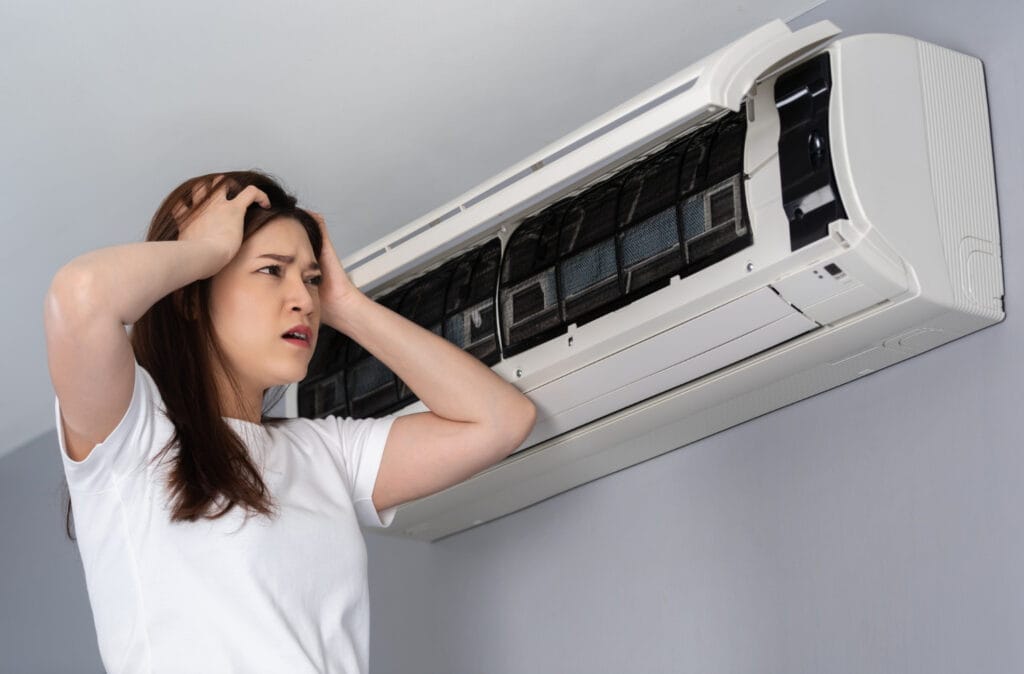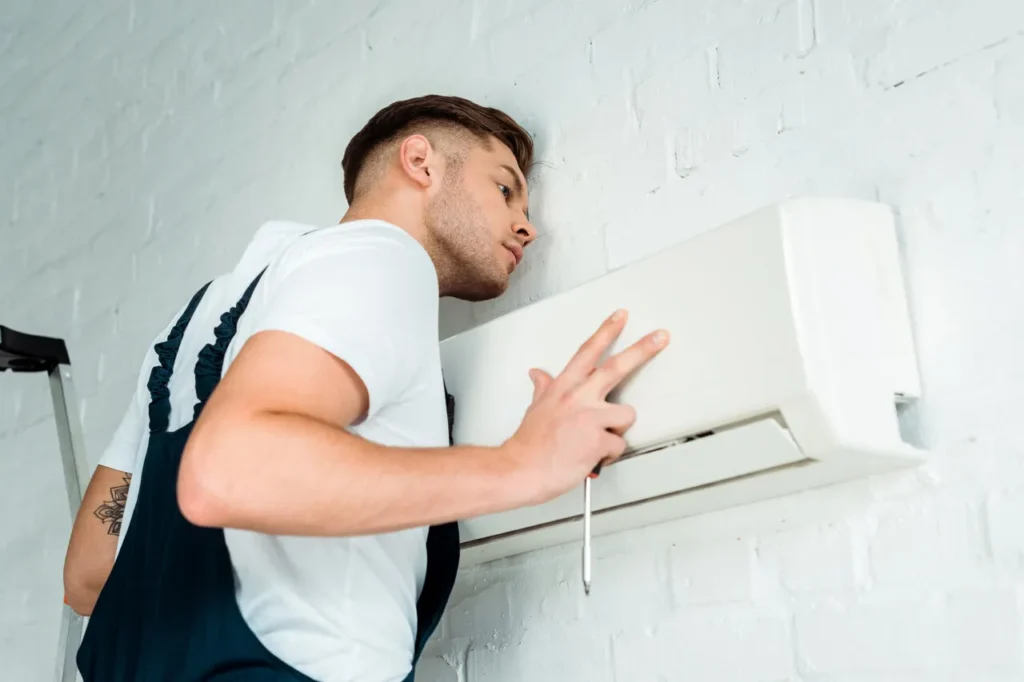There’s nothing quite like the relief of stepping into a cool, air-conditioned room on a sweltering summer day. It’s a feeling we often take for granted—until suddenly, there’s no cold air coming from your vents.
Your air conditioner is running, but the air it’s blowing is anything but cold.

This is a common issue that can disrupt your comfort and productivity, especially if you’re working from home or running a small business. But don’t sweat it just yet.
Understanding why your AC is not blowing cold air is the first step towards solving the problem. It could be due to a variety of reasons, from dirty filters to refrigerant leaks, or even electrical issues.
In this comprehensive guide, we’ll walk you through the process of troubleshooting your AC. We’ll explain the common culprits, provide a step-by-step guide to diagnosing the issue, and offer tips on when it’s time to call a professional.
Whether you’re a stay-at-home mom juggling work and kids, a small business owner striving for customer satisfaction, or a work-from-home professional needing a cool environment, this guide is for you.
Let’s dive in and get that cool air flowing again.
Understanding Your AC System
Knowing the basics of how your air conditioner operates can be incredibly helpful. Not only does it help in troubleshooting, but it also aids in communicating with a professional. At its core, an air conditioner works by removing warm air from your space and replacing it with cooler air.
The system comprises several key components working harmoniously. These include the evaporator coil, which absorbs heat, and the condenser coil, which expels it outside. The compressor plays a vital role, circulating refrigerant between these coils to cool your home efficiently.
Several factors are crucial for optimal AC performance. Let’s break down the essentials:
- Thermostat: Sets the desired temperature and controls the system.
- Air Filters: Trap dust and debris, maintaining airflow and air quality.
- Ductwork: Delivers cooled air throughout the home.
- Refrigerant: Circulates in a loop, changing from gas to liquid to cool the air.
Issues within any of these components can lead to a system that doesn’t cool properly. For example, a malfunctioning thermostat might not signal the unit to kick on.
However, understanding these components can guide you to potential problem areas. Regular maintenance is key to preventing breakdowns and ensuring efficiency.
Knowledge empowers you to identify when something’s amiss. This means you can act swiftly, either with a DIY fix for minor issues or by calling an expert for more complex problems. Keeping your system well-maintained also leads to greater comfort and energy savings in the long run. By recognizing these basics, you’ll better appreciate the complex yet vital role your AC plays in day-to-day comfort.
Common Culprits When AC Is Not Blowing Cold Air
When your air conditioner runs but fails to cool, several common culprits might be at play. Identifying these issues early on can save time, money, and discomfort. Let’s explore the usual suspects causing your AC woes.
First, consider the role of your thermostat settings. A simple misconfiguration can lead to a cooler-less environment. Always start by ensuring it’s set to the desired cooling temperature.
Next, air filters are integral for clear airflow. When clogged, they can stifle performance. This is an easy fix you might handle yourself to restore efficient cooling.

Refrigerant, the substance cooling the air, can present issues as well. If levels are low due to a leak, your system won’t cool effectively. Spotting this early requires a bit more expertise, usually necessitating a professional.
Here’s a quick checklist of potential AC issues:
- Dirty or clogged air filters
- Refrigerant leaks or low levels
- Thermostat misconfigurations
- Frozen evaporator coils
- Dirty condenser coils
- Electrical issues and tripped breakers
- Ductwork leaks or obstructions
Understanding these can help you pinpoint the problem. Now, let’s dive deeper into each specific issue.
Dirty or Clogged Air Filters
Air filters play a pivotal role in your HVAC system. They capture dust, dander, and other particles, ensuring clean airflow. Over time, filters can become clogged with debris.
When filters are dirty, airflow is restricted, lowering efficiency. This can cause the system to struggle to cool your space. Changing or cleaning filters monthly can prevent this problem.
Replacing the filters is often a simple DIY task. However, if neglected, clogged filters can lead to more severe issues. Regular check-ups help maintain peak performance, keeping your home comfortable.
Refrigerant Issues
Refrigerant is crucial to the cooling process. It cycles through the system, transitioning between gas and liquid states to absorb and release heat. However, refrigerant can develop leaks, diminishing cooling capacity.
Low refrigerant levels typically indicate a leak needing professional repair. Without adequate levels, your AC can run constantly without effectively cooling. It’s vital to address this promptly.
Detecting a refrigerant issue usually requires professional equipment. If you suspect a leak, contacting an expert ensures safe and effective resolution. This prevents potential environmental harm and restores comfort.
Thermostat Troubles
The thermostat acts as the brain of your AC system. Misconfigurations can prevent it from correctly signaling the unit, leading to cooling issues. Always verify that settings are correct before delving deeper into troubleshooting.
Dead batteries or improper placements can also contribute to thermostat malfunctions. Consider placement, ensuring it’s away from heat sources like windows. Regularly replace batteries to avoid unexpected glitches.
If settings appear correct and issues persist, it might be time to upgrade your thermostat. Smart thermostats offer enhanced control and insights, aligning with modern convenience expectations.
Frozen Evaporator Coils
Evaporator coils are key in heat absorption. When they freeze, cooling efficiency plummets. Common causes for this freeze are restricted airflow or refrigerant problems.
Frost on coils indicates an underlying issue, such as blocked airflow from dirty filters. Addressing this promptly is crucial as prolonged freezing can damage the system.
Switch the system off to allow coils to thaw and replace any clogged filters. If freezing persists, consult a professional to evaluate refrigerant levels or other components.
Dirty Condenser Coils
Condenser coils, located outside, expel heat from the refrigerant. If they’re dirty, your AC struggles to cool effectively. Dirt, debris, or grass clippings can cover coils, impeding their function.
Cleaning condenser coils is important but often overlooked. Regularly inspect and clean them to maintain optimal efficiency. Use a gentle brush or hose for surface dirt removal.
For deeper cleaning, consider hiring a professional. Ensuring clear coils supports system longevity and keeps your environment cool on those scorching days.
Electrical Problems and Tripped Breakers
Electrical issues can cause cooling systems to malfunction. Circuit breakers can trip if they’re overloaded or faulty, cutting power to your AC. This is common in older systems or during peak usage.

Always check your breaker panel if your unit loses power. Reset tripped breakers but avoid repeated resets as this indicates a deeper issue. Wiring problems can also interfere with performance.
Call a professional for persistent electrical issues. They can assess breaker panels, wiring, and connections ensuring safety and reliable AC operation, critical during intense summer heat.
Ductwork Dilemmas
The ductwork is essential for distributing cooled air throughout your home. Obstructions or leaks can hinder this distribution, leading to uneven cooling or inefficiency. Leaky ducts can allow cool air to escape before reaching intended spaces.
Inspect ducts visually for damage or disconnections and patch them as needed. Balance dampers if rooms cool unevenly. Duct sealing and insulation upgrades may also be beneficial.
Contact an HVAC professional to conduct a thorough duct inspection. They can identify and repair leaks efficiently, enhancing your system’s cooling performance and preserving energy.
Step-by-Step Troubleshooting Guide
Troubleshooting your AC unit when it’s not blowing cold air can seem daunting. However, breaking down the process into manageable steps can make it easier. Let’s walk through a methodical approach to identifying and resolving common AC issues.
Start by reviewing your thermostat settings. It’s a simple but often overlooked task. Ensure the settings align with your desired temperature.
Next, move on to your air filters and coils. Clean filters and coils are crucial for effective operation. Their cleanliness impacts airflow and cooling efficiency.
Evaluating refrigerant levels requires more attention. While a professional often handles this, understanding its significance aids in identifying potential leaks.
Electrical components may also be affecting your system. Check for tripped breakers or faulty wiring. This step ensures the unit receives adequate power.
Finally, inspect the ductwork and vents. Obstructed or leaky ducts can cause uneven cooling and inefficiency. Ensuring these pathways are clear is essential for proper air distribution.
These steps offer a comprehensive approach to troubleshooting. They help pinpoint problems and decide if professional intervention is needed.
Check Your Thermostat
Begin with the thermostat, the simplest place to start. Verify that it’s set to “cool” and the temperature is below room level.
Sometimes thermostat placements cause issues. If near a heat source, it may misread room temperatures. Adjust the location if necessary.
Make sure to review the thermostat’s batteries. Often, dead or weak batteries can affect its performance. Replacing them may solve your problem quickly.
Inspect Air Filters and Coils
Air filters should be examined regularly. Clogged filters hinder airflow, diminishing your AC’s performance drastically. Replace or clean filters once a month for best results.
The coils, both evaporator and condenser, require attention too. Dust and debris accumulation can reduce their efficiency. Gently clean them using a soft brush or vacuum for optimal operation.
For coil cleaning beyond surface dust, consider seeking professional help. Expertise ensures thorough cleaning without damaging delicate components.
Evaluate Refrigerant Levels
Low refrigerant levels typically point to a leak, not simply depletion. Have a qualified technician inspect and replenish refrigerant to restore cooling capability.
Recognizing refrigerant-related issues involves noting diminished cooling or hissing sounds near lines. These are signs of leaks affecting your system’s operation.
Avoid attempting to handle refrigerant on your own. Professionals have the necessary tools and knowledge to address and correct any issues safely.
Assess Electrical Components
For electrical troubleshooting, begin by checking circuit breakers. Tripped breakers often halt AC units. Reset them if tripped, but not repeatedly, which indicates a more extensive problem.
Inspect wiring for visible wear or disconnections. Damaged wiring can prevent the system from receiving power, impacting function. Professional assessment may be required to resolve complex electrical problems.
Electric failures can also occur inside the unit. Should the system lose power frequently, expert diagnosis is prudent for safety.
Examine Ductwork and Vents
Ducts and vents play pivotal roles in distributing cooled air throughout the space. Conduct visual inspections for disconnections or blockages, remedying as needed.
Ensure vents are unobstructed by furniture or debris. Blocked vents impair air distribution, causing rooms to cool unevenly. Realign furniture where necessary for improved airflow.
If common fixes don’t help, hire professionals for a comprehensive duct inspection. They can identify underlying issues, promoting efficient cooling and maximizing comfort.
When to Call a Professional HVAC Technician
Despite your best efforts, some AC issues are best left to the pros. Identifying when to call a technician saves time and prevents further damage. Let’s explore how to recognize these situations and why professional maintenance is invaluable.
Complex issues often appear simple at first. For example, consistent cooling failures or unusual noises could indicate severe underlying problems. These situations require professional tools and expertise to diagnose accurately.
Consider the system’s age. Units over ten years old frequently need expert care to maintain efficiency. Component wear and evolving technology mean seasoned hands can ensure continued reliability.
Moreover, professionals provide peace of mind. They bring comprehensive knowledge, cutting-edge tools, and skills built over years. Their expertise identifies root causes, delivering effective, enduring solutions.
Recognizing Complex Issues
When your AC behaves unusually, it’s often indicative of deeper problems. Consistent inefficiency, leaking refrigerant, or short cycling may indicate significant malfunctions.
Attempting to fix these alone may worsen the situation. If initial troubleshooting doesn’t resolve the problem, it’s time to consult a professional. Their specialized insight prevents complications, ensuring your system’s longevity.
The Benefits of Professional Maintenance
Professional maintenance provides unparalleled value. Routine inspections catch minor issues before they escalate, extending the unit’s life. This proactive approach saves on costly repairs in the long run.
Additionally, regularly serviced units operate more efficiently. Technicians clean, calibrate, and optimize your system, thus reducing energy bills. A well-maintained AC enhances comfort, efficiency, and peace of mind, proving why expert attention is crucial.
Preventative Measures and Regular Maintenance Tips
Preventative measures are key to avoiding AC malfunctions and ensuring year-round comfort. With a few regular practices, you can keep your system running smoothly and efficiently. Here are some essential maintenance tips to consider:
- Change air filters every 1-3 months.
- Keep the condenser unit clear of debris.
- Clean evaporator and condenser coils annually.
- Check refrigerant levels regularly.
- Inspect ducts for leaks or damage.
These practices go a long way in preserving your system’s health. Routine maintenance reduces strain on components, lowering the risk of unexpected breakdowns.
Additionally, remember that a little attention goes a long way in enhancing performance. Clean components increase airflow, which improves cooling capacity and efficiency.
Engage in regular inspections to catch minor issues early. Quick resolutions prevent them from turning into costly repairs later on.
Keeping Your AC Clean
A clean AC performs efficiently and lasts longer. Dust and debris can restrict airflow, causing the system to work harder. Regular cleaning of filters, coils, and surrounding areas can prevent this.
Keep the outdoor unit clear of leaves and branches. Trim vegetation within two feet to ensure sufficient airflow. A little upkeep keeps your AC functioning at its best.
Scheduling Annual Check-Ups
Annual check-ups by professionals are vital for your AC’s health. They offer a thorough evaluation of all components. This ensures that any hidden issues are addressed before they escalate.
When scheduling, choose a reputable HVAC service. Timely inspections mean your system remains reliable throughout the year. Regular professional attention ensures comfort and efficiency for your home.
Conclusion: Ensuring Comfort and Efficiency
Ensuring your air conditioning system operates smoothly is crucial for comfort and productivity. Regular maintenance and timely troubleshooting can prevent common problems, saving you stress and money.
Prioritize keeping your system clean and well-maintained. Doing so ensures maximum efficiency, extends the lifespan of your unit, and keeps energy costs down. Implement these practices for a more comfortable and efficient home environment. For complex issues or annual check-ups, don’t hesitate to reach out to professionals who can provide expert care and peace of mind.
No Cold Air? Contact LC Heating and Air Conditioning for Expert Assistance
If your air conditioning troubles persist despite your best efforts, it may be time to call in the professionals. At LC Heating and Air Conditioning, we pride ourselves on providing top-notch service with a friendly touch.
Whether you’re dealing with a minor hiccup or a major malfunction, our experienced team is here to help. Serving the Los Angeles metropolitan area, we’re just a call away at (818)858-7080. Reach out today, and let us restore your comfort and peace of mind swiftly and efficiently. Visit our website at lahvaclc.com for more details.


